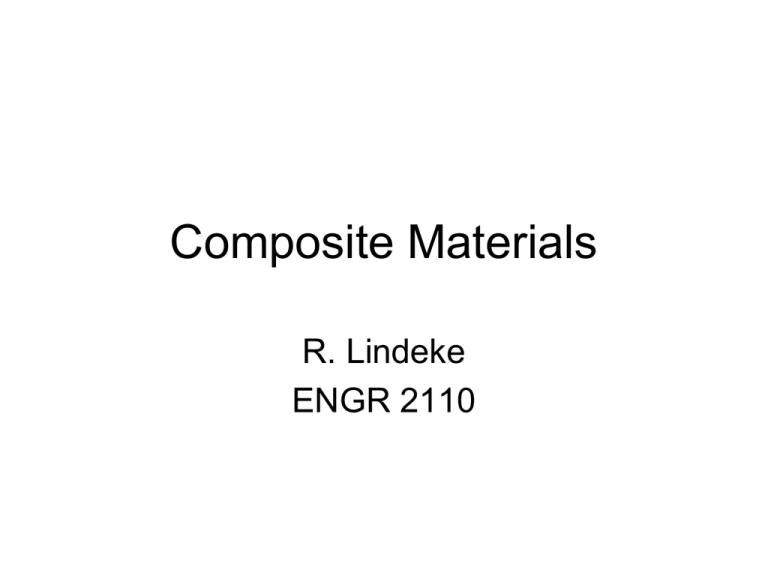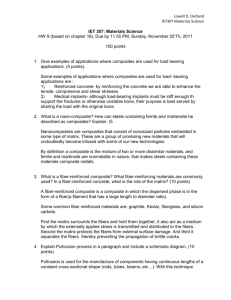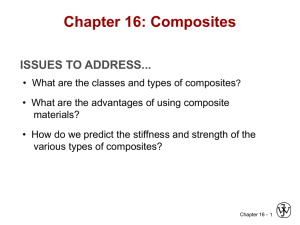Composite Materials
advertisement

Composite Materials R. Lindeke ENGR 2110 Introduction • A Composite material is a material system composed of two or more macro constituents that differ in shape and chemical composition and which are insoluble in each other. The history of composite materials dates back to early 20th century. In 1940, fiber glass was first used to reinforce epoxy. • Applications: – – – – Aerospace industry Sporting Goods Industry Automotive Industry Home Appliance Industry Advanced Aerospace Application: Lear Fan 2100 “all-composite” aircraft Advanced Aerospace Application: Boeing 767 (and in 777, 787 airplanes w/ the latest, full wing box is composite): Terminology/Classification • Composites: -- Multiphase material w/significant proportions of each phase. woven fibers • Matrix: -- The continuous phase -- Purpose is to: 0.5 mm - transfer stress to other phases - protect phases from environment -- Classification: metal MMC, CMC, PMC ceramic cross section view polymer • Dispersed phase: -- Purpose: enhance matrix properties. MMC: increase sy, TS, creep resist. CMC: increase Kc PMC: increase E, sy, TS, creep resist. -- Classification: Particle, fiber, structural 0.5 mm Reprinted with permission from D. Hull and T.W. Clyne, An Introduction to Composite Materials, 2nd ed., Cambridge University Press, New York, 1996, Fig. 3.6, p. 47. Composite Structural Organization: the design variations Composite Survey Composites Particle-reinforced Largeparticle Dispersionstrengthened Fiber-reinforced Continuous (aligned) Structural Discontinuous (short) Aligned Randomly oriented Laminates Sandwich panels Adapted from Fig. 16.2, Callister 7e. Composite Benefits • CMCs: Increased toughness Force 103 E(GPa) 102 PMCs 10 particle-reinf fiber-reinf 10 -4 6061 Al ess (s-1) 10 -6 10 -8 10 -10 metal/ metal alloys .1 G=3E/8 polymers .01 K=E .1 .3 1 3 10 30 Density, r [mg/m3] Bend displacement Increased creep resistance ceramics 1 un-reinf • MMCs: • PMCs: Increased E/r 6061 Al w/SiC whiskers 20 30 50 Adapted from T.G. Nieh, "Creep rupture of a silicon-carbide reinforced aluminum composite", Metall. Trans. A Vol. 15(1), pp. 139-146, 1984. Used with permission. s(MPa) 100 200 Composite Survey: Particle-I Particle-reinforced • Examples: - Spheroidite matrix: ferrite (a) steel Fiber-reinforced (ductile) 60 mm - WC/Co cemented carbide matrix: cobalt (ductile) Vm : 5-12 vol%! Structural particles: cementite (Fe3 C) (brittle) particles: WC (brittle, hard) Adapted from Fig. 10.19, Callister 7e. (Fig. 10.19 is copyright United States Steel Corporation, 1971.) Adapted from Fig. 16.4, Callister 7e. (Fig. 16.4 is courtesy Carboloy Systems, Department, General Electric Company.) 600 mm - Automobile matrix: rubber tires particles: C (stiffer) (compliant) 0.75 mm Adapted from Fig. 16.5, Callister 7e. (Fig. 16.5 is courtesy Goodyear Tire and Rubber Company.) Composite Survey: Particle-II Particle-reinforced Fiber-reinforced Structural Concrete – gravel + sand + cement - Why sand and gravel? Sand packs into gravel voids Reinforced concrete - Reinforce with steel rebar or remesh - increases strength - even if cement matrix is cracked Prestressed concrete - remesh under tension during setting of concrete. Tension release puts concrete under compressive force - Concrete much stronger under compression. - Applied tension must exceed compressive force Post tensioning – tighten nuts to put under rod under tension but concrete under compression nut threaded rod Composite Survey: Particle-III Particle-reinforced Fiber-reinforced Structural • Elastic modulus, Ec, of composites: -- two approaches. E(GPa) 350 Data: Cu matrix 30 0 w/tungsten 250 particles 20 0 150 upper limit: “rule of mixtures” Ec = VmEm + VpEp 0 lower limit: 1 Vm Vp = + c m E E Ep 20 40 60 80 (Cu) • Application to other properties: Adapted from Fig. 16.3, Callister 7e. (Fig. 16.3 is from R.H. Krock, ASTM Proc, Vol. 63, 1963.) 10 0 vol% tungsten (W) -- Electrical conductivity, se: Replace E in the above equations with se. -- Thermal conductivity, k: Replace E in above equations with k. Composite Survey: Fiber Particle-reinforced Fiber-reinforced Structural • Fibers themselves are very strong – Provide significant strength improvement to material – Ex: fiber-glass • Continuous glass filaments in a polymer matrix • Strength due to fibers • Polymer simply holds them in place and environmentally protects them Fiber Loading Effect under Stress: Composite Survey: Fiber Particle-reinforced Fiber-reinforced Structural • Critical fiber length (lC) for effective stiffening & strengthening: fiber strength in tension sf d fiber length 15 c fiber diameter shear strength of fiber-matrix interface • Ex: For fiberglass, a fiber length > 15 mm is needed since this length provides a “Continuous fiber” based on usual glass fiber properties • Why? Longer fibers carry stress more efficiently! Shorter, thicker fiber: Longer, thinner fiber: s d sf d fiber length 15 f fiber length 15 c c s(x) s(x) Adapted from Fig. 16.7, Callister 7e. Poorer fiber efficiency Better fiber efficiency Fiber Load Behavior under Stress: s*f d lc 2 c Composite Survey: Fiber Particle-reinforced Fiber-reinforced Structural • Fiber Materials – Whiskers - Thin single crystals - large length to diameter ratio • graphite, SiN, SiC • high crystal perfection – extremely strong, strongest known • very expensive – Fibers • polycrystalline or amorphous • generally polymers or ceramics • Ex: Al2O3 , Aramid, E-glass, Boron, UHMWPE – Wires • Metal – steel, Mo, W Fiber Alignment Adapted from Fig. 16.8, Callister 7e. aligned continuous aligned random discontinuous Behavior under load for Fibers & Matrix Composite Strength: Longitudinal Loading Continuous fibers - Estimate fiber-reinforced composite strength for long continuous fibers in a matrix • Longitudinal deformation sc = smVm + sfVf volume fraction Ece = Em Vm + EfVf Ff E f Vf Fm E mVm but ec = em = ef isostrain longitudinal (extensional) modulus Remembering: E = s/e f = fiber m = matrix and note, this model corresponds to the “upper bound” for particulate composites Composite Strength: Transverse Loading • In transverse loading the fibers carry less of the load and are in a state of ‘isostress’ sc = sm = sf = s 1 Vm Vf E ct E m E f ec= emVm + efVf transverse modulus Remembering: E = s/e and note, this model corresponds to the “lower bound” for particulate composites An Example: UTS, SI Modulus, SI 57.9 MPa 3.8 GPa 2.4 GPa 399.9 GPa (241.5 GPa) (9.34 GPa) Note: (for ease of conversion) 6870 N/m2 per psi! Composite Strength Particle-reinforced Fiber-reinforced Structural • Estimate of Ec and TS for discontinuous fibers: sf d -- valid when fiber length 15 c -- Elastic modulus in fiber direction: Ec = EmVm + KEfVf efficiency factor: -- aligned 1D: K = 1 (aligned ) -- aligned 1D: K = 0 (aligned ) -- random 2D: K = 3/8 (2D isotropy) -- random 3D: K = 1/5 (3D isotropy) Values from Table 16.3, Callister 7e. (Source for Table 16.3 is H. Krenchel, Fibre Reinforcement, Copenhagen: Akademisk Forlag, 1964.) -- TS in fiber direction: (TS)c = (TS)mVm + (TS)fVf (aligned 1D) Composite Survey: Fiber Particle-reinforced Fiber-reinforced • Aligned Continuous fibers • Examples: -- Metal: g'(Ni3Al)-a(Mo) -- Ceramic: Glass w/SiC fibers formed by glass slurry Eglass = 76 GPa; ESiC = 400 GPa. by eutectic solidification. matrix: a (Mo) (ductile) (a) 2 mm fibers: g ’ (Ni3Al) (brittle) From W. Funk and E. Blank, “Creep deformation of Ni3Al-Mo in-situ composites", Metall. Trans. A Vol. 19(4), pp. 987-998, 1988. Used with permission. Structural (b) fracture surface From F.L. Matthews and R.L. Rawlings, Composite Materials; Engineering and Science, Reprint ed., CRC Press, Boca Raton, FL, 2000. (a) Fig. 4.22, p. 145 (photo by J. Davies); (b) Fig. 11.20, p. 349 (micrograph by H.S. Kim, P.S. Rodgers, and R.D. Rawlings). Used with permission of CRC Press, Boca Raton, FL. Composite Survey: Fiber Particle-reinforced Fiber-reinforced • Discontinuous, random 2D fibers • Example: Carbon-Carbon -- process: fiber/pitch, then burn out at up to 2500ºC. -- uses: disk brakes, gas turbine exhaust flaps, nose cones. (b) C fibers: very stiff very strong C matrix: less stiff view onto plane less strong • Other variations: -- Discontinuous, random 3D -- Discontinuous, 1D Structural (a) Ec = EmVm + KEfVf efficiency factor: -- random 2D: K = 3/8 (2D isotropy) -- random 3D: K = 1/5 (3D isotropy) fibers lie in plane Looking at strength: l lC s cd lC ' s V f 1 s m 1 V f 2 l f where s f is fiber fracture strength & s m is matrix stress when composite fails ' l lC s cd ' l C V f s m' 1 V f d where: d is fiber diameter & C is smaller of Matrix Fiber shear strength or matrix shear yield strength Composite Survey: Structural Particle-reinforced Fiber-reinforced Structural • Stacked and bonded fiber-reinforced sheets -- stacking sequence: e.g., 0º/90º or 0/45/90º -- benefit: balanced, in-plane stiffness • Sandwich panels -- low density, honeycomb core -- benefit: light weight, large bending stiffness face sheet adhesive layer honeycomb Adapted from Fig. 16.18, Callister 7e. (Fig. 16.18 is from Engineered Materials Handbook, Vol. 1, Composites, ASM International, Materials Park, OH, 1987.) Adapted from Fig. 16.16, Callister 7e. Composite Manufacturing Processes • Particulate Methods: Sintering • Fiber reinforced: Several • Structural: Usually Hand lay-up and atmospheric curing or vacuum curing Irwin/McGraw-Hill © 2000 Th e McGraw- Hill Comp anies, Inc., Open Mold Processes Only one mold (male or female) is needed and may be made of any material such as wood, reinforced plastic or , for longer runs, sheet metal or electroformed nickel. The final part is usually very smooth. Shaping. Steps that may be taken for high quality 1. Mold release agent (silicone, polyvinyl alcohol, fluorocarbon, or sometimes, plastic film) is first applied. 2. Unreinforced surface layer (gel coat) may be deposited for best surface quality. Hand Lay-Up: The resin and fiber (or pieces cut from prepreg) are placed manually, air is expelled with squeegees and if necessary, multiple layers are built up. · Hardening is at room temperature but may be improved by heating. · Void volume is typically 1%. · Foam cores may be incorporated (and left in the part) for greater shape complexity. Thus essentially all shapes can be produced. · Process is slow (deposition rate around 1 kg/h) and labor-intensive · Quality is highly dependent on operator skill. · Extensively used for products such as airframe components, boats, truck bodies, tanks, swimming pools, and ducts. SPRAY-UP MOLDING A spray gun supplying resin in two converging streams into which roving is chopped · Automation with robots results in highly reproducible production · Labor costs are lower Tape-Laying Machines (Automated Lay-Up) Cut and lay the ply or prepreg under computer control and without tension; may allow reentrant shapes to be made. · Cost is about half of hand lay-up · Extensively used for products such as airframe components, boats, truck bodies, tanks, swimming pools, and ducts. • Filament Winding – Ex: pressure tanks – Continuous filaments wound onto mandrel Adapted from Fig. 16.15, Callister 7e. [Fig. 16.15 is from N. L. Hancox, (Editor), Fibre Composite Hybrid Materials, The Macmillan Company, New York, 1981.] Filament Winding Characteristics ۰Because of the tension, reentrant shapes cannot be produced. ۰CNC winding machines with several degrees of freedom (sometimes 7) are frequently employed. ۰The filament (or tape, tow, or band) is either precoated with the polymer or is drawn through a polymer bath so that it picks up polymer on its way to the winder. ۰Void volume can be higher (3%) ۰The cost is about half that of tape laying ۰Productivity is high (50 kg/h). ۰Applications include: fabrication of composite pipes, tanks, and pressure vessels. Carbon fiber reinforced rocket motor cases used for Space Shuttle and other rockets are made this way. Pultrusion ۰ Fibers are impregnate with a prepolymer, exactly positioned with guides, preheated, and pulled through a heated, tapering die where curing takes place. ۰Emerging product is cooled and pulled by oscillating clamps ۰Small diameter products are wound up ۰Two dimensional shapes including solid rods, profiles, or hollow tubes, similar to those produced by extrusion, are made, hence its name ‘pultrusion’ Composite Production Methods Pultrusion – Continuous fibers pulled through resin tank, then preforming die & oven to cure Adapted from Fig. 16.13, Callister 7e. ۰Production rates around 1 m/min. ۰Applications are to sporting goods (golf club shafts), vehicle drive shafts (because of the high damping capacity), nonconductive ladder rails for electrical service, and structural members for vehicle and aerospace applications. PREPREG PRODUCTION PROCESSES ۰Prepreg is the composite industry’s term for continuous fiber reinforcement pre-impregnated with a polymer resin that is only partially cured. ۰Prepreg is delivered in tape form to the manufacturer who then molds and fully cures the product without having to add any resin. ۰This is the composite form most widely used for structural applications PrePreg Process ۰ Manufacturing begins by collimating a series of spool-wound continuous fiber tows. ۰ Tows are then sandwiched and pressed between sheets of release and carrier paper using heated rollers (calendering). ۰ The release paper sheet has been coated with a thin film of heated resin solution to provide for its thorough impregnation of the fibers. PrePreg Process ۰ The final prepreg product is a thin tape consisting of continuous and aligned fibers embedded in a partially cured resin ۰ Prepared for packaging by winding onto a cardboard core. ۰ Typical tape thicknesses range between 0.08 and 0.25 mm ۰ Tape widths range between 25 and 1525 mm. ۰ Resin content lies between about 35 and 45 vol% PrePreg Process ۰The prepreg is stored at 0C (32 F) or lower because thermoset matrix undergoes curing reactions at room temperature. Also the time in use at room temperature must be minimized. Life time is about 6 months if properly handled. ۰Both thermoplastic and thermosetting resins are utilized: carbon, glass, and aramid fibers are the common reinforcements. ۰Actual fabrication begins with the lay-up. Normally a number of plies are laid up to provide the desired thickness. ۰The lay-up can be by hand or automated. Summary • Composites are classified according to: -- the matrix material (CMC, MMC, PMC) -- the reinforcement geometry (particles, fibers, layers). • Composites enhance matrix properties: -- MMC: enhance sy, TS, creep performance -- CMC: enhance Kc -- PMC: enhance E, sy, TS, creep performance • Particulate-reinforced: -- Elastic modulus can be estimated. -- Properties are isotropic. • Fiber-reinforced: -- Elastic modulus and TS can be estimated along fiber dir. -- Properties can be isotropic or anisotropic. • Structural: -- Based on build-up of sandwiches in layered form.






